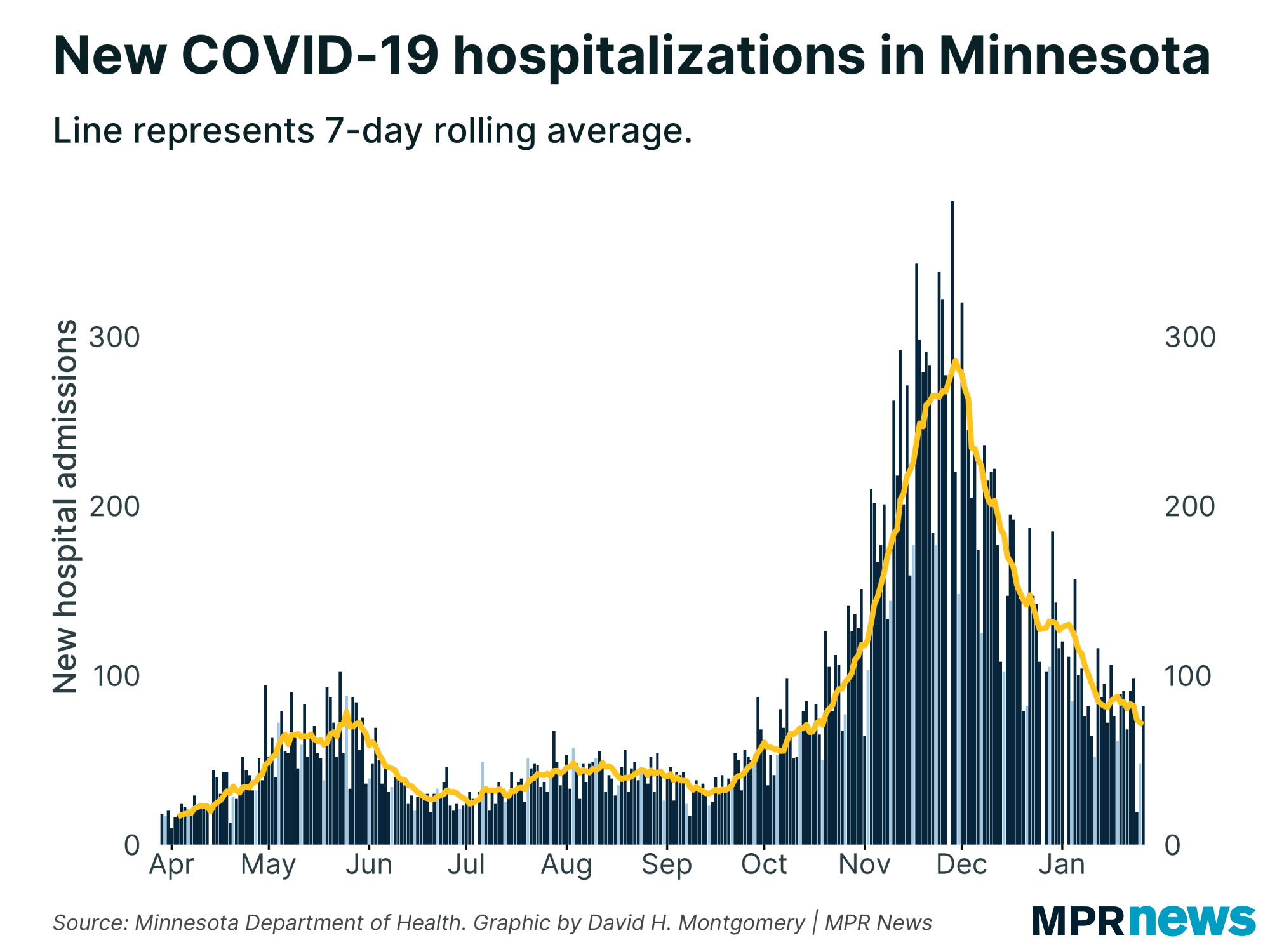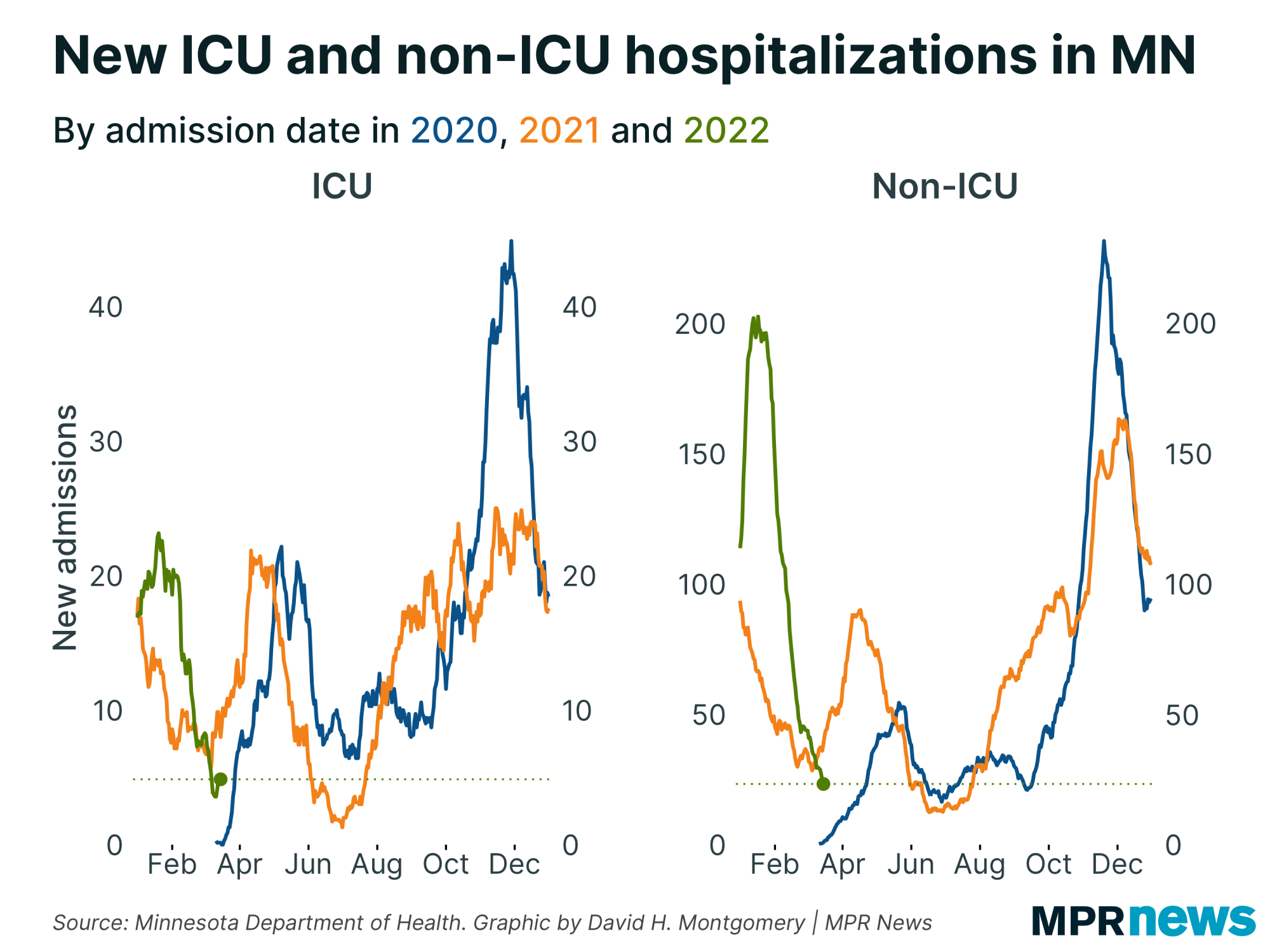Dec. 30 update on COVID-19 in MN: 66 more deaths; 2K new cases

Go Deeper.
Create an account or log in to save stories.
Like this?
Thanks for liking this story! We have added it to a list of your favorite stories.
Updated 12:30 p.m.
Minnesota officials on Wednesday reported 66 new COVID-19 deaths and 2,019 new cases as a week of hope and uncertainty continued.
The count of known, active cases in Minnesota continued to fall to near 12,000, a level not seen since late October, part of an overall slowdown in caseloads since their late November, early December peak.

Hospitalization trends have also improved significantly over the past two weeks. As of Tuesday, 926 people were in the hospital with COVID-19 in Minnesota, with 207 needing intensive care. Both numbers are down by about half from their late November peaks.

Still, the state reported 66 more deaths from the disease. More than 2,800 Minnesotans have died from COVID-19 complications during November and December. That’s more than half of all pandemic deaths, with December the deadliest month by far.
Turn Up Your Support
MPR News helps you turn down the noise and build shared understanding. Turn up your support for this public resource and keep trusted journalism accessible to all.

State health officials have warned that the improving picture could change dramatically if people don’t stay vigilant. They continue to implore people to wear masks in indoor gathering spaces, socially distance and take other measures to help stem the spread of COVID-19.
The cases reported Wednesday put Minnesota at 413,107 in the pandemic. Of those, roughly 96 percent have recovered to the point they no longer need to be isolated.

The newly reported deaths raised Minnesota’s toll to 5,262. Among those who’ve died, about 65 percent had been living in long-term care or assisted living facilities; most had underlying health problems.
Caseloads spread across age groups
People in their 20s still make up the age bracket with the state’s largest number of confirmed cases — nearly 79,000 since the pandemic began, including nearly 42,000 among people ages 20 to 24.

The number of high school-age youth confirmed with the disease has also grown, with more than 32,000 total cases among those ages 15 to 19 since the pandemic began.
Although less likely to feel the worst effects of the disease and end up hospitalized, experts worry youth and young adults will spread it to grandparents and other vulnerable populations.
It’s especially concerning because people can have the coronavirus and spread COVID-19 when they don’t have symptoms.

New cases ebb across Minnesota
Central and western Minnesota drove much of the increase in new cases over the past two months, while Hennepin and Ramsey counties showed some of the slowest case growth in the state.
Cases continue to fall statewide, with most regions dipping down to levels before the state’s COVID-19 surge that hit in November and early December.

Hot spots continue to pop up in rural counties relative to their population.

Caseloads still heaviest among people of color
In Minnesota and across the country, COVID-19 has hit communities of color disproportionately hard in both cases and deaths. That’s been especially true for Minnesotans of Hispanic descent for much of the pandemic.

Even as new case counts ease from their peak a few weeks ago, the data shows people of color continue to be hit hardest.
Distrust of the government, together with deeply rooted health and economic disparities, have hampered efforts to boost testing among communities of color, officials say, especially among unauthorized immigrants who fear their personal information may be used to deport them.
Similar trends have been seen among Minnesota’s Indigenous residents. Counts among Indigenous people jumped in October relative to population.
Nearly 40K vaccinated so far
Nearly two weeks into Minnesota's vaccine distribution program, about 38,000 people have received their first shots.
Many hospitals started vaccinating their front-line workers the week of Dec. 21, with a few starting days before that. Long-term care providers started vaccinating residents this week, with nearly 600 given so far.
The state has so far received nearly 80,000 doses of the Pfizer vaccine and nearly 95,000 of the Moderna vaccine. That vaccine is mostly being used to inoculate people living and working in skilled nursing facilities.
The state is on track to have received 250,000 doses by the end of Thursday.
Despite questions about the pace of vaccinations, state officials said that vaccination was actually proceeding more quickly, but that the data is delayed and incomplete at this point.
Kris Ehresmann, the state’s infectious disease director, said Wednesday that the “average Minnesotan” — people who don’t fall into a high risk health category or a priority category such as health care workers and first responders — should anticipate getting vaccinated in late spring or early summer.
Developments around the state
A 106-year-old among nursing home residents in central Minnesota to receive COVID-19 vaccine
Health providers CentraCare and Carris Health have began giving out the Moderna COVID-19 vaccine to residents of several long-term care facilities this week.

At Carris Health Care Center in Willmar, Minn., 20 residents received the first dose on Tuesday.
The first resident to receive a vaccine was Harriet Lobbins, who's 106 years old.
She recovered after having COVID-19 in mid-November.
CentraCare says residents who have already had the coronavirus and meet the guidelines will still receive the vaccine.
Nearly two weeks into Minnesota's vaccine distribution program, about 38,000 people have received their first shots. Vaccinations of health care workers and residents of long-term care facilities are expected to continue for the next few weeks.
— Kirsti Marohn | MPR News
Sauk Centre hospital returns to routine operations as COVID-19 patient number drops
A Sauk Centre, Minn., hospital temporarily designated for patients with COVID-19 is returning to normal operations this week.
In November, CentraCare designated its hospital in Sauk Centre for less critical patients with COVID-19. The move was aimed at easing pressure on its largest hospital in St. Cloud, Minn., where the sickest patients are treated.
Since then, the numbers of people admitted to the hospital and intensive care unit have declined.
Dr. George Morris, medical incident commander for CentraCare's COVID-19 response team, says the number of patients in the ICU has dropped from a high of 59 to more normal levels of 17 to 22 daily.
"We're at a point now, where we can see that we're consistently on the downward trend, and that we can push them back into more their regular work,” Morris said. “We have more employees on site. And we've managed ways. Each time we go through these crises, we learn."
Morris said staffing levels also are back closer to normal. At one point, roughly 10 percent of CentraCare's 13,000 employees were out due to exposure to or testing positive for the virus, or caring for a family member.
Morris said more than 2,000 CentraCare employees have now received a first dose of COVID-19 vaccine, along with residents and staff of five long-term care facilities.
— Kirsti Marohn | MPR News
AG Ellison files suit to halt Winnebago New Year's Eve event
Minnesota Attorney General Keith Ellison said Wednesday he wants to shut down a planned New Year's Eve party in Winnebago because it violates Gov. Tim Walz's executive order on activities that could hasten the spread of COVID-19.
Ellison said in a release that the Carlson Event Center in the southeastern Minnesota town advertises the event as a “big new year's dance” and asks attendees to bring their own beer and liquor. The release said phone calls and emails to the business have not been returned.
Ellison said when a business “irresponsibly opens to the public to throw a dance party” it is "simply prolonging the pain of the pandemic for everyone."
Garth Carlson, owner of the facility, told the Star Tribune that Ellison's depiction of the event is wrong.
“He doesn’t know what he’s talking about,” Carlson said. “It’s not a party. It’s not a bash. It’s a religious gathering.”
The attorney general's lawsuit asks a judge to stop the party, award damages to the state and impose civil penalties.
— The Associated Press
Mpls. firefighters and EMTs get first vaccines
Minneapolis firefighters and emergency personnel have started to receive COVID-19 vaccines.
Dozens lined up to get their shots at the city's emergency operations training center Tuesday morning.
Up first was Minneapolis Fire Chief Bryan Tyner.
"I don't feel like as chiefs we can ask people to do something that we're not willing to do ourselves," Tyner said.
Firefighters will be followed by city and Metro Transit police. The city is working through which employees will need the vaccine next.
”We're going to make sure that that all city employees who want to get vaccinated are able to, but we're definitely going to take care of the ones who are higher risk first,” said Toni Hauser, the emergency preparedness manager for the Minneapolis Health Department.
Hauser said the city is weighing factors such as close regular contact with the public and how essential the employees’ jobs are.
Emergency personnel are included in the same priority group as frontline health care workers and nursing home residents.
— Peter Cox | MPR News
Top headlines
Opposition to Minnesota's bar and restaurant COVID-19 restrictions still bubbling: Gov. Tim Walz’s emergency restrictions on inside drinking and dining run through Jan. 10, and opponents say some establishments continue to quietly defy the order. Minnesota Attorney General Keith Ellison said he’ll continue to bring cases against businesses that are not complying.
California announces first confirmed case of COVID-19 variant: California has announced its first confirmed case of the new and apparently more contagious variant of the coronavirus. It was the second such case documented in the U.S. in a day.
Pandemic brings a Dakota woman home to southern Minnesota: Back in March, reporter Dan Kraker met Pat Northrup in her Cloquet, Minn., apartment where she danced a jingle dress dance with her family and friends. Since then, the pandemic has upended her life; someone in her apartment contracted the virus and Northrup, who's now 70, decided to move to her daughter's house, only a few miles west of the Lower Sioux Indian Community where she grew up.
In the midst of a pandemic, an adoptee connects with her birth father: Just as Susan McCrea was getting to know her birth father, the pandemic hit. But despite a virus that prevented her from spending more time with her relatives in person, she says she's never felt more connected — to her roots, and to her family, old and new.
As state COVID-19 relief goes out, some will miss out: Initial state aid payments for businesses that will be sent out soon won't help some Minnesota restaurants struggling with the latest round of COVID-19 restrictions because of how they fared when regulations were loosened earlier.
COVID vaccinations ramp up in Minn. long-term care: Staff and residents in nursing homes and other long-term care facilities across the state began getting their first doses of the COVID-19 vaccine Monday, a hopeful sign in an industry hard-hit by the virus.
COVID-19 in Minnesota
Data in these graphs are based on the Minnesota Department of Health's cumulative totals released at 11 a.m. daily. You can find more detailed statistics on COVID-19 at the Health Department website.




